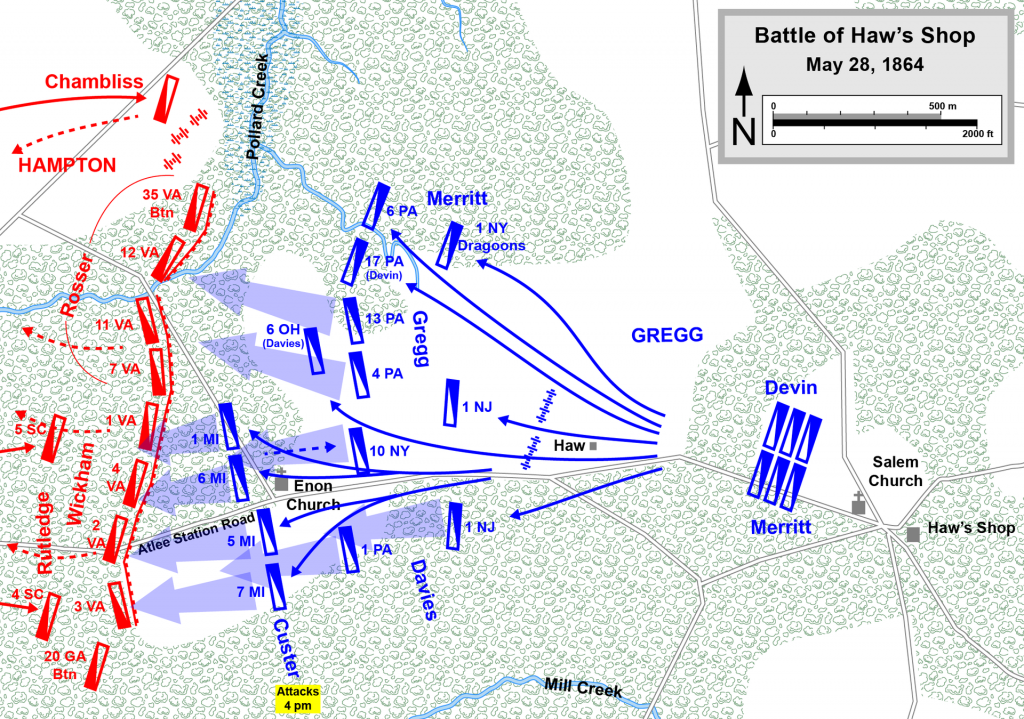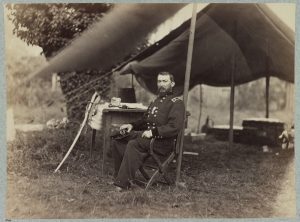A Comprehensive View of the Overland Campaign, Part IV
Part of a Series – Part I and Part II and Part III
Forgotten Victories
Grant wrote to Halleck on May 26 stating “Lee’s army is really whipped.”[1] He found that Lee was unable to attack his positions at North Anna and believed that the Army of Northern Virginia was bound to break. As Grant maneuvered the Army of the Potomac farther south, David M. Gregg encountered the newly appointed Confederate cavalry commander, Wade Hampton, near Haws Shop. Desperate fighting occurred between the two forces all day on May 28 as each side attacked and counter-attacked without much success. It was not until luck paved the way for Union success. A Confederate soldier mistakenly identified a dismounted soldier as infantry, relaying this information to Hampton.[2] He ordered his men to fall back, but George Custer’s Michigan Wolverines pursued in force. Sheridan managed to score a tactical victory at Haws Shop, but Lee now knew that Grant was moving south to Bethesda Church.[3]
Such aggressiveness led Grant to believe in the weakening of the Army of Northern Virginia. The arrival of Custer’s men aided in the pursuit and tactical victory at Haws Shop. It was that aggressive culture that Grant desired among the Army of the Potomac. Gordon Rhea, an author of multiple books on the Overland Campaign, blamed Sheridan for not asking Meade for reinforcements because he was uncomfortable utilizing them in battle.[4] However, Rhea seems to forget that Sheridan fought as an infantryman in the western theatre and used them successfully during the Appomattox Campaign. Sheridan writes in his memoirs that he did ask for reinforcements from Meade, but Meade reported back that Hancock’s men are too weary of engaging the enemy.[5] Sheridan has no reason to lie about such a request because Hancock’s II Corps was worn down and overused. Despite the contentious relationship between the two men, Sheridan understood massing forces together to overwhelm the enemy. Clausewitz said that “the success of the attack is the result of a present superiority of force, it being understood that the moral as well as physical forces are included.”[6] Sheridan would order Torbert to reinforce Gregg at Haws Shop. Hampton’s failure reflected his responsibility to distinguish false intelligence from all the information coming into headquarters. Hampton taking up a defensive position near Haws Shop ceded the initiative to the Federal cavalry. It was only a matter of time before their army was going to break.

The battle of Haw’s Shop was further evidence that the Army of Northern Virginia could not claim victory on an open field or possessed an offensive capacity. It would lead both armies to Totopotomoy Creek, where II Corps found the Army of Northern Virginia firmly entrenched on May 29. In the meantime, Grant called up reinforcements from Benjamin Butler bottled up on the James River peninsula. Butler sent him to the XVIII Corps under William F. Smith. Grant utilized a concentrated force to strike Lee’s army despite the slight difference in numbers between Grant and Lee. Clausewitz stated that “There is only one exception to the principle of directing all our strength against the centre of gravity of the enemy’s power, that is, if ancillary expeditions promise extraordinary advantages, and still, in this case, it is a condition assumed, that we have such a decisive superiority as enables us to undertake such enterprises without incurring too great risk at the point which forms our great object.”[7] Grant knew Butler could hold the James River peninsula without the XVIII Corps, and Butler had yet to move on Petersburg; therefore, it was of more use for the XVIII Corps to be a part of an offensive operation.[8] Even without these reinforcements, the Federals scored several small Federal tactical victories near Bethesda Church and Cold Harbor.
Despite the II Corps stalled position at Totopotomoy Creek, Warren’s V Corps repelled a feeble attack made by General Early’s II Corps on May 30. That same day The Army of the Potomac’s cavalry corps under the charismatic Sheridan engaged Confederate cavalry near Old Church. It is here Grant issues orders to Meade that display his coup d’oeil,
It is not improbable that the enemy, being aware of Smith’s movement, will be feeling to get on our left flank for the purpose of cutting him off, or by a dash to crush him and get back before we are aware of it. Sheridan ought to be notified to watch the enemy’s movements well out towards Cold Harbor, and also on the Mechanicsville road. Wright should be got well massed on Hancock’s right so that if it becomes necessary, he can take the place of the latter readily.[9]
Grant saw the tactical importance of the Cold Harbor crossroads and knew it would become of importance to the enemy. This view would lead to the capture of Cold Harbor Crossroads the following day.
Therefore, on 31 May 1864, Sheridan received orders from Meade to hold the Cold Harbor crossroads at all hazards. Wright’s VI Corps was ordered to Old Cold Harbor, but before he arrived, Sheridan successfully repulsed two different Confederate assaults.[10] Wright and three of Smith’s divisions launched a successful assault against the Confederate lines on June 1while Lee attempted to relieve the pressure on his right by launching multiple offensives against the Federal right.[11] None of Lee’s assaults succeeded, thereby providing Grant more confidence in the destruction of the Army of Northern Virginia. However, June 2 Early attacked V and IX Corps as they were repositioning for the following day. Grant was disgusted by their lack to launch a counter-attack.[12] Initially, Grant planned on assaulting the Confederate line on June 2 as the II Corps marched south to the Federal left. The march was grueling and left them exhausted. Due to over-exhaustion by the II Corps, Meade persuaded Grant to postpone the assault the following day.[13]

Federal tactical victories occurred between May 27 and June 1, which solidified Grant’s belief that the rebel army would break. It is rightly attributed to the Confederate cavalry that their performance led to significant reports on the whereabouts of Grant’s army. Nonetheless, what Lee did not possess was an advanced intelligence network like the Bureau of Military Intelligence. Often neglected in interpretation, Grant utilized this intelligence system on multiple occasions finding varying degrees of success. One such example is the BMI reported the location of James Longstreet before the battle of the Wilderness.[14] It determined where and when Grant should move the army. Unlike the western theatre, the BMI did not provide the same adequate information. Reports indicated that rebel morale was shaky and Grant remained adamant that the Army of Northern Virginia was going to crack.[15] This information proved wrong, but between June 27-June1, Grant utilized speed and tempo to hold the initiative. Even though Lee located the Army of the Potomac, he could only react and continued dancing to Grant’s tune.
Bibliography
Clausewitz, Carl von. On War. Kansas: Digireads, 2018.
Feis, William. Grant’s Secret Service: The Intelligence War from Belmont to Appomattox, Neb: University of Nebraska Press, 2002.
Grant, Ulysses. Personal Memoirs of U.S. Grant. New York: The Library of America, 1990.
Kreiser, Lawrence and Kreiser, Jr. Defeating Lee: A History of the Second Corps, Army of the Potomac. IN: Indiana University Press, 2011.
Rhea, Gordon. Cold Harbor: Grant and Lee. Baton Rouge: Louisiana State Press, 2002.
Sheridan, Philip. The Personal Memoirs of P. H. Sheridan. MA: Da Capo Press, 1992.
U.S. War Department, The War of Rebellion: A Compilation of the Official Records of the Union and Confederate Armies vol. 36. Washington DC: Government Printing Press, 1884.
Wittenberg, Eric. Six Awful Days of Fighting. North Carolina: Fox Run Publishing, 2020.
[1] U.S. War Department, The War of Rebellion: A Compilation of the Official Records of the Union and Confederate Armies vol. 36, (Washington DC: Government Printing Press, 1884), 206.
[2] Eric Wittenberg, Six Awful Days of Fighting, (North Carolina: Fox Run Publishing, 2020), 125.
[3] Ibid, 138.
[4] Gordon Rhea, Cold Harbor: Grant and Lee, (Baton Rouge: Louisiana State Press, 2002), 88.
[5] Philip Sheridan, The Personal Memoirs of P. H. Sheridan, (MA: Da Capo Press, 1992), 218.
[6] Carl von Clausewitz, On War, (Kansas: Digireads, 2018), 488.
[7] Ibid, 572.
[8] U.S. War Department, The War of Rebellion: A Compilation of the Official Records of the Union and Confederate Armies vol. 36, (Washington DC: Government Printing Press, 1884), 245.
[9] U.S. War Department, The War of Rebellion, 323
[10] Ulysses Grant, Personal Memoirs of U.S. Grant (New York: The Library of America, 1990), 495.
[11] Ibid, 497.
[12] Ulysses Grant, Personal Memoirs of U.S. Grant, 498.
[13] Lawrence Kreiser and Kreiser, Jr. Defeating Lee: A History of the Second Corps, Army of the Potomac, (IN: Indiana University Press, 2011), 183.
[14]William Feis, Grant’s Secret Service: The Intelligence War from Belmont to Appomattox, (Lincoln, Neb: University of Nebraska Press, 2002), 201
[15] Ibid, 211.

As regards the aftermath of the Battle of Haws Station, I suggest the author reread the actual conclusion drawn by Rhea as regards the lost opportunity presented to Grant/Meade. It’s found on page 88. Rhea calls into question Sheridan’s rationalization contained much later in his memoirs. Sheridan’s after battle report contained no indication of this alleged request for infantry reinforcements. And as Rhea points out, it was not merely the II Corps that was available, but portions of the 5th and 6th as well. When presented with an enemy with forces divided by a significant military stream, neither Eugene at Zenta nor Napoleon at Friedland hesitated to demand and expect their troops to rise to the occasion. But then, they were great captains.